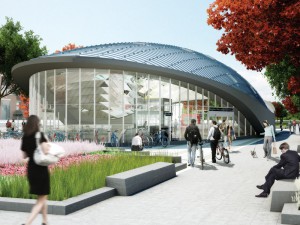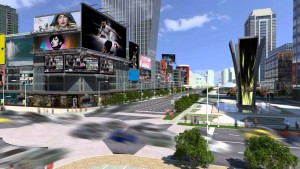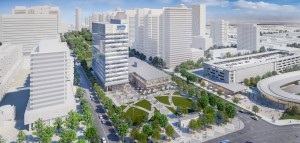Share This
Related Posts
Tags
Vaughan Metropolitan Centre
By Erica Rascón on May 27, 2015 in News
Building along public transit lines has long been a popular way to ensure that traffic flows easily to a retail property. A lack of transit options does not have to deter an otherwise promising develo pment. At Vaughan Metropolitan Centre in Canada, Yardi client Calloway REIT demonstrates how to build smart, minimize sprawl, and convince transit authorities to collaborate when funds are scarce.
pment. At Vaughan Metropolitan Centre in Canada, Yardi client Calloway REIT demonstrates how to build smart, minimize sprawl, and convince transit authorities to collaborate when funds are scarce.
Calloway has built its reputation on creating strategically located shopping centers of exceptional quality. When considering the next project, team leaders took a few factors into consideration:
- Canada hasn’t seen the construction of an enclosed shopping mall in over 20 years.
- The City of Vaughan is growing but lacks an adequate downtown to meet the expectations of businesses and residents.
- The market was ready for something big, new and exciting—without the downside of urban sprawl and traffic congestion.
Calloway, in a 50/50 joint venture with SmartCentres, stepped forward to address those factors with a project in the burgeoning Vaughan Metropolitan Centre (VMC), a pedestrian-friendly hub for businesses, residences, and entertainment.
Calloway’s carefully selected locations can be easily accessed by more than 85 percent of Canadians. Keeping with this tradition, the company selected a 50 acre portion of a 442-acre parcel in Vaughan, part of York Region northwest of Toronto, as the project’s site. It was ideal for Vaughan’s new downtown and it had ample space for retail, office, and residential accommodations. There was only one major problem: transit lines stopped in Toronto nearly 25 miles away.
 A lack of transit access would adversely affect the ability to fund and market the project. Studies by Urban Land Institute state that 91 percent of public leaders regard transportation infrastructure quality as the top influencer of real estate investment and development decisions. 86 percent of private leaders rated transportation infrastructure as the second highest priority. The households of the future—Gen Y and Millennials—are steadily seeking out neighborhoods and employment centers that facilitate public transit use as an alternative to car ownership. Public transit tops many lists, and the vision of VMC couldn’t thrive without it.
A lack of transit access would adversely affect the ability to fund and market the project. Studies by Urban Land Institute state that 91 percent of public leaders regard transportation infrastructure quality as the top influencer of real estate investment and development decisions. 86 percent of private leaders rated transportation infrastructure as the second highest priority. The households of the future—Gen Y and Millennials—are steadily seeking out neighborhoods and employment centers that facilitate public transit use as an alternative to car ownership. Public transit tops many lists, and the vision of VMC couldn’t thrive without it.
Though the importance of public transit is growing, the City needed an incentive to direct its limited funds to a transit station at VMC. APTA recorded $2,205.6 million regular users bringing in a total operating revenue of $3,762.7 for all of Canada. Those figures aren’t groundbreaking, but studies suggest that the profitability of public transit will only improve. If the City of Vaughan wanted to grow, it was in its best interest to support the vision of VMC.
The three entities met halfway. Calloway and SmartCentres donated 2.5 acres of land to Toronto Transit Commission (TTC) for the new station.
“People ask, ‘How did you strategically make this happen?’ As stupid as it sounds, we just waited for the phone to ring,” laughs Rudy Gobin, Executive Vice President of Asset Management at Calloway REIT and former Executive Vice President, Finance and Operations of SmartCentres. “We already owned the land. The City called and said they wanted to put a subway stop on the street edge of the property. It took us about six months to negotiate this but we said, ‘Why don’t you put it in the middle of the property and we’ll give you the land?’ They wanted 2.5 acres of land in the middle of 50 acres. They said sure and that was that. And of course, we then acquired additional land nearby.”
Toronto York Spadina Subway Extension Project provided additional funding. The construction on Vaughan Centre Station at VMC was soon underway.
Vaughn Centre Station will connect residents of York Region to Downtown Toronto. The new station will be the northernmost point along the TTC network, and only the second station operated by TTC outside of the City of Toronto.
Mitchell Goldhar, President and Owner of SmartCentres says, “This joint venture with Calloway will leverage the strengths of both companies and will be implemented by a team of urban planning and development professionals with extensive experience. You cannot underestimate the impact of a subway on developable land.”
The rest of the planning for VMC was business as usual:
Calloway uses a system of capital recycling to fund new projects. After evaluating the performance of each asset in their portfolio, the company releases the bottom 10 percent and uses the capital to invest in one or two properties with greater potential. VMC was one such project, the largest in Calloway’s history, which will increase the company’s square footage of pipeline assets by approximately 75% to almost seven million square feet.
Of that square footage, VMC will hold:
- 750,000 square feet of retail space as home to more than 200 retailers
- More than 5 million square feet of office space
- 12,000 residential units
The construction and operation of VMC will bring over 11,000 jobs to Vaughan, approximately 5,000 of which will be office-based.
Calloway’s Vaughan Metropolitan Centre model demonstrates that vast projects can continue to be profitable for REITs without resulting to short-term risks and urban sprawl. By placing public transit as a top priority and collaborating with transit authorities, REITS can improve upon their tried and true business strategies while appealing to changing consumer trajectories.
